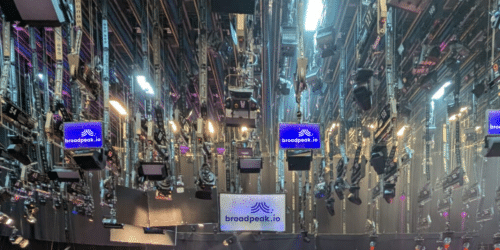We were bound to talk about the technology powering FAST given our work at broadpeak.io where we ambition to stream the content people love with a compelling user experience.
As mentioned in our previous blog, any company can, in theory, start a FAST channel. When you read channel, you immediately think about broadcast channels like the BBC, CNN or TF1, and it makes you wonder how a company can start a TV channel business from scratch. It must be costly and time consuming.
Let us take you through the process that goes into the creation and launch of a FAST channel.
What are the key ingredients to launch a FAST channel?
Those are the 4 main steps to launch a FAST channel:
1. Step N°1 – Content
The phrase “Content is King” gets old but is as relevant as ever. You don’t launch a channel for the sake of it. You aim at bringing content that users want to watch, it’s as simple as that.
With 100+ FAST channels on most FAST platforms (and over 300 channels on some US platforms), it’s crucial to address the most thought-after genres (news, sports, reality TV, recognizable IPs) while looking for the gaps in the platform’s offering. There’s not enough room for 10 True crime channels on a given platform.
Once you have nailed your channel concept, you license 3rd-party content and/or build from your existing library. FAST Platforms expect a minimum of 50-100 hours per channel with a 25% monthly refresh. The most successful FAST channels carry more than 150 hours of programs to avoid content fatigue.
When your pool of programs is ready, it’s time to schedule your channel and gone are the days where FAST channels were playlists with programs stitched together. A lot more thinking goes into the channel programming.
2. Step N°2 – Programming
Most FAST channels are now more and more scheduled by Broadcast TV Channel experts who have the know-how. A channel follows a musical partition.
At a macro level, the scheduler builds a channel grid with programming blocks around specific genres and dayparts. Each daypart brings a different demographic and therefore a different target audience. The average minute viewed varies as well during the day and on weekdays versus weekends.
Your macro-programming is done, now it’s time to build a minute-by-minute planning and decide:
- What program will be featured and when;
- How often within the same week/month;
- When do ad breaks come in; how often.
Scheduling strategies are a must to ensure you attract and retain an audience with the right piece of content, the right ad, at the right time.
Proven tactics from the Broadcast world are relevant for FAST too:
- Lead-ins and lead-outs around a tentpole program;
- Hammocking: a lesser-known program scheduled between tentpoles;
- Bridging by airing promos for the next program;
- Counterprogramming: to attract viewers away from another programming e.g. non-sports viewers during a major sports event.
- Stripping running a series at a specific time throughout the week
- Marathons: back to back episode of a series.
As you can see, there’s a lot of magic happening behind the curtains to make your viewing experience the best possible.
One last piece of scheduling is essential in FAST: placing ad markers according to the ad load requirements and strategy of the channel and the wider platform.
3. Step N°3 – Channel creation
Now, how do you actually schedule a channel and turn it into a feed?
That’s where technology comes in.
TV scheduling tools have existed for years. You can use your existing scheduler or the one from your technology vendor if you are new to scheduling.
With the growth of FAST, a set of existing and new technology vendors entered the space: the FAST enablers.
They, early on, saw the opportunity FAST presented and they diversified their product and service portfolios to address this new business.
FAST enablers often come from the Broadcast industry (Amagi, Red Bee, Harmonic), the OTT Cloud SaaS (OKAST, OTTera) or are pure players (Wurl, Frequency).
They all offer scheduling tools with more and more advanced features to automate the scheduling process. You must set up an end-to-end workflow with your vendor across:
- Encoding
- Origin
- Assets and metadata ingestion,
- Scheduling,
- Overlay graphics,
- Data analytics,
- Monetization,
- Encoding
- Origin
- Playout.
Ultimately, they turn your schedule into a video feed and an EPG (Electronic Press Guide) according to the platform specifications.
Your channel is ready to go but where to?
4. Step N°4 – Distribution
If Content is King, then Distribution is Queen as there’s no point in having a beautifully curated channel if it’s not live on the major FAST Platforms.
Securing distribution for your channel is one of the hardest jobs of a FAST channel owner.
In our 3rd blog of the FAST series, we detailed the growing FAST Platform ecosystem and as a FAST channel owner, you are in front of 20+ platforms in the US, 10+ in Europe and the list goes on if you wish to be live globally. Few platforms have a global footprint and even when they do, it doesn’t mean that the monetization potential is there (more on that in our 5th blog on monetization).
Assuming you have the knowledge and network to seek distribution, each platform will have an editorial say into the relevance of your channel. They will ask themselves:
- Is the content distinctive?
- Is the brand strong enough?
- Does it answer a consumer need?
- Which audience can be served?
- Is it advertising worthy?
To maximize channel pick up, you can do two things:
- Avoid at all costs to build a channel without gaining platform insights first;
- Inquire about the FAST platforms your FAST enabler is interconnected with. Their existing relationships with platforms will be an incredible asset for your business.
FAST is growing up
Running a FAST channel looks more and more like running a TV channel.
Yesterday, FAST 1.0 channels were playlists of programs stitched together.
Today, FAST channels are mostly curated manually by programmers, although FAST enablers work towards automation.
In addition, the output of the channel creation process is one feed for everyone. The ad experience will be personalized based on the viewer but the programming will be the same for everyone.
Tomorrow, we strongly believe that automation and personalization will become the new normal and technological innovations are much needed.
This will be FAST 2.0.
At broadpeak.io, we are already active on that front. Together with Spideo (a Content Recommendation Platform), we built a Personalized Virtual Channel Solution to put technology to work where it matters i.e. to address content providers’ pain points and to delight viewers.
Automated linear channel programming is done combining Spideo recommendation technologies with Broadpeak custom streaming solutions. The system can go further into personalization by generating personalized schedules based on individual attributes.
Last Step: Monetisation
In our final blog post, we will explore the business model behind FAST as it is crucial to understand how channels monetize their viewership, which is no small task.
The FAST Blog Series – Part 5/5 to be posted soon!










